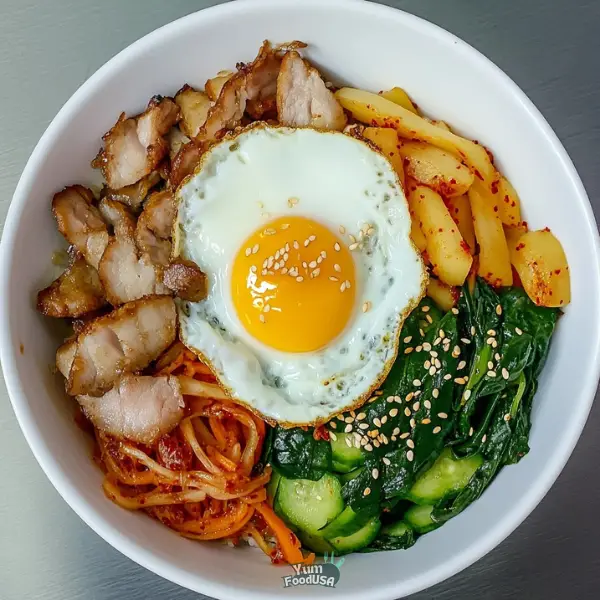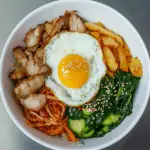Bibimbap is a classic Korean rice bowl featuring a perfect combination of marinated meat, sautéed vegetables, a fried egg, and a spicy gochujang (Korean chili paste) sauce, all served over warm short-grain rice. A delicious and nutritious meal with a burst of vibrant flavors.
Why You’ll Love This Recipe
Bibimbap is a beautiful balance of textures and flavors, from the tender, savory marinated pork or beef to the crispy fried egg and the fresh crunch of sautéed vegetables. The gochujang sauce adds a fiery kick that ties everything together, making each bite a flavorful experience. This dish is both satisfying and nourishing, and it’s customizable to your preferences, whether you like it spicier, with more veggies, or extra protein. Whether you’re new to Korean cuisine or a long-time fan, Bibimbap will quickly become a favorite in your home-cooked meals.
Ingredients
For the Rice Bowl:
- 2 cups cooked short-grain rice (warm)
- 1/2 cup spinach, sautéed
- 1/2 cup bean sprouts, blanched
- 1/2 cup carrots, julienned
- 1/2 zucchini, sliced and sautéed
- 1/2 lb pork or beef (marinated with soy sauce, sesame oil, garlic, and sugar)
- 1 egg (fried)
- 2 tablespoons gochujang (Korean chili paste)
- 1 teaspoon sesame oil
- 1 teaspoon sesame seeds (optional)
- Pickled radish or kimchi (optional)
(Tip: You can find the complete list of ingredients and their measurements in the recipe card below.)
Directions
- In a hot skillet, sauté the spinach in a little sesame oil until wilted, then set aside.
- Blanch the bean sprouts in hot water for 2-3 minutes and drain.
- In the same skillet, sauté the julienned carrots and zucchini until softened.
- In a separate pan, cook the marinated pork or beef until tender, and set aside.
- Fry an egg sunny-side up in a little oil, keeping the yolk intact.
- To assemble the bibimbap, place a serving of warm rice at the bottom of each bowl.
- Arrange the sautéed vegetables, cooked meat, and fried egg on top of the rice in an aesthetically pleasing manner.
- Drizzle gochujang sauce over the top and drizzle with sesame oil.
- Garnish with sesame seeds and optional pickled radish or kimchi.
- Mix everything together before eating to blend the flavors.
Servings and Timing
- Servings: 2 servings
- Prep Time: 15 minutes
- Cooking Time: 15 minutes
- Total Time: 30 minutes
Variations
- Vegetarian Version: Replace the meat with tofu or tempeh for a vegetarian alternative. Marinate the tofu in soy sauce and sesame oil for added flavor.
- Extra Veggies: Add extra vegetables like mushrooms, bell peppers, or cucumber to increase the freshness and texture of the dish.
- Extra Spicy: Add more gochujang sauce or some fresh chili peppers to intensify the heat for a spicier version.
- Different Meat: You can substitute pork or beef with chicken or even seafood, like shrimp or fish, for a different flavor profile.
Storage/Reheating
- Storage: Bibimbap is best enjoyed fresh, but if you have leftovers, store the components (vegetables, meat, and rice) separately in airtight containers in the refrigerator for up to 2 days.
- Reheating: Reheat the rice and vegetables in the microwave or on the stovetop. For the fried egg, it’s best to cook a fresh one when reheating.
FAQs
Can I use regular rice instead of short-grain rice?
Short-grain rice is traditional for bibimbap, as it’s sticky and helps hold the ingredients together. However, you can use long-grain rice or brown rice if you prefer.
Can I make bibimbap with chicken instead of beef or pork?
Yes, chicken is a great alternative! Marinate boneless, skinless chicken thighs or breasts in the same marinade and cook until tender.
How do I make the gochujang sauce less spicy?
You can reduce the amount of gochujang sauce or mix it with a little more sesame oil or honey to mellow out the heat.
How do I store leftovers?
For leftovers, keep the rice, meat, and veggies separate, and store them in airtight containers. The egg is best cooked fresh, but you can store it separately and reheat it quickly.
Can I use other vegetables in bibimbap?
Yes, you can use other vegetables like bell peppers, cabbage, or spinach. Just sauté or blanch them until tender and add them to the bowl.
Can I skip the pickled radish or kimchi?
Yes, while pickled radish or kimchi is traditional and adds a tangy flavor, you can skip it if you prefer a milder taste.
How do I make the bibimbap more savory?
For a richer flavor, you can add a drizzle of sesame oil and a little extra soy sauce to the rice before assembling the dish.
How can I make bibimbap spicier?
Add extra gochujang to the sauce or include more sliced chili peppers in the toppings.
Can I use a non-stick skillet to cook the meat?
Yes, a non-stick skillet will work well for cooking the meat, especially if you prefer to avoid excess oil.
What other sauces can I use besides gochujang?
If you prefer a milder flavor, you can substitute gochujang with a mixture of soy sauce, sesame oil, and a dash of rice vinegar.
Conclusion
Bibimbap is a colorful, flavorful dish that brings together a variety of textures and tastes in one delicious bowl. The combination of grilled meat, sautéed vegetables, a fried egg, and the spicy kick from gochujang makes it a satisfying and nourishing meal. Whether you’re new to Korean cuisine or a long-time fan, this bibimbap recipe is a perfect way to enjoy a classic dish at home.
PrintBibimbap (Korean Rice Bowl)
A delicious Korean rice bowl featuring vegetables, marinated meat (typically pork or beef), a fried egg, and finished with a spicy gochujang (Korean chili paste) sauce for a burst of flavor.
- Prep Time: 15 minutes
- Cook Time: 15 minutes
- Total Time: 30 minutes
- Yield: 2 servings 1x
- Category: Main Course
- Method: Sautéing
- Cuisine: Korean
Ingredients
- For the rice bowl:
- 2 cups cooked short-grain rice (warm)
- 1/2 cup spinach, sautéed
- 1/2 cup bean sprouts, blanched
- 1/2 cup carrots, julienned
- 1/2 zucchini, sliced and sautéed
- 1/2 lb pork or beef (marinated with soy sauce, sesame oil, garlic, and sugar)
- 1 egg (fried)
- 2 tablespoons gochujang (Korean chili paste)
- 1 teaspoon sesame oil
- 1 teaspoon sesame seeds (optional)
- Pickled radish or kimchi (optional)
Instructions
- In a hot skillet, sauté the spinach in a little sesame oil until wilted, then set aside.
- Blanch the bean sprouts in hot water for 2-3 minutes and drain.
- In the same skillet, sauté the julienned carrots and zucchini until softened.
- In a separate pan, cook the marinated pork or beef until tender, and set aside.
- Fry an egg sunny-side up in a little oil, keeping the yolk intact.
- To assemble the bibimbap, place a serving of warm rice at the bottom of each bowl.
- Arrange the sautéed vegetables, cooked meat, and fried egg on top of the rice in an aesthetically pleasing manner.
- Drizzle gochujang sauce over the top and drizzle with sesame oil.
- Garnish with sesame seeds and optional pickled radish or kimchi.
- Mix everything together before eating to blend the flavors.
Notes
- If you want a milder flavor, you can adjust the amount of gochujang sauce according to your taste.
- For extra crunch, you can add some sliced cucumber or a fried shallot topping.
- Feel free to swap the pork or beef for chicken, tofu, or another protein of your choice.
Nutrition
- Serving Size: 1 bowl
- Calories: 450 kcal
- Sugar: 7g
- Sodium: 750mg
- Fat: 20g
- Saturated Fat: 3g
- Unsaturated Fat: 13g
- Trans Fat: 0g
- Carbohydrates: 45g
- Fiber: 5g
- Protein: 25g
- Cholesterol: 150mg


